
About UsThe Numismatic Bibliomania Society is a non-profit organization promoting numismatic literature. For more information please see our web site at coinbooks.org SubscriptionsThose wishing to become new E-Sylum subscribers (or wishing to Unsubscribe) can go to the following web page link MembershipThere is a membership application available on the web site Membership Application To join, print the application and return it with your check to the address printed on the application. Membership is only $15 to addresses in the U.S., $20 for First Class mail, and $25 elsewhere. For those without web access, write to: David M. Sundman, Secretary/TreasurerNumismatic Bibliomania
Society AsylumFor Asylum mailing address changes and other membership questions, contact David at this email address: dsundman@LittletonCoin.com SubmissionsTo submit items for publication in The E-Sylum, just Reply to this message, or write to the Editor at this address: whomren@coinlibrary.com
BUY THE BOOK BEFORE THE COINYou won't regret it! |
- WAYNE'S WORDS: THE E-SYLUM JUNE 17, 2012
- THE ASYLUM VOLUME 30, NO 1 PUBLISHED
- KOLBE & FANNING 125TH MAIL-BID SALE HIGHLIGHTS
- LAKE BOOKS 111TH MAIL-BID SALE PRICES REALIZED AVAILABLE
- OTTAWA NUMISMATIC SOCIETY MONETA PUBLICATION IS NOW FREE
- NEW BOOK: THE PAPER CURRENCY OF TIBET
- A MEMORIAL TRIP TO KEENE, NEW HAMPSHIRE
- NOTES FROM E-SYLUM READERS: JUNE 3, 2012
- PRESIDENTIAL COIN AND ANTIQUE COMPANY AUCTION 82
- WASHINGTON POST ARTICLE ON THIEVES TARGETING COIN DEALERS
- QUERY: EARLY EDITION OF RAYMOND'S STANDARD CATALOGUE OF U.S. COINS
- THE SMELL OF MONEY
- WAYNE'S NUMISMATIC DIARY: JUNE 17, 2012
- THE NUMISMATOURIST'S LATEST TRAVELS IN EUROPE
- DONOR REPATRIATING 10,000 HISPANIC COINS TO ANS
- BAR-KOCHBA ERA TREASURE HOARD DISCOVERED
- RUMORS DRIVE CROWDS TO PURCHASE ONE-RUPEE COINS
- EDWARD VIII'S HIDDEN WATCH COIN
- FEATURED WEB PAGE: THE ROYAL MINT MUSEUM
WAYNE'S WORDS: THE E-SYLUM JUNE 17, 2012

New subscribers this week include Homer Shrader, Ed Nicolai, Mark Cadden and Brian Silliman. Welcome aboard! We have 1,554 email subscribers, plus 180 followers on Facebook.
So we're back in business with this issue. I'm still far behind on email, but gradually catching up. I've been out of town this weekend, but still managed to pull together a nice issue. This week we open with an update on our print journal, The Asylum, followed by notes on two recent numismatic literature sales.
Other topics include coin dealer thefts, The Numismatourist's latest travels, and King Edward VIII hidden watch coin.
Have a great week, everyone!
THE ASYLUM VOLUME 30, NO 1 PUBLISHED
 George F. Kolbe - The Literature of Numismatic Literature
George F. Kolbe - The Literature of Numismatic Literature
Myron Xenos - "You Don't Say": Numismatic Quarterly Quiz
Elizabeth Hahn - Something to Celebrate: Collaboration among Specialized Libraries
Joel J. Orosz - John Quincy Adams and the Other Report upon Weights, Measures, and Coins
To access the membership application, see: www.coinbooks.org/club_nbs_member_app.html
KOLBE & FANNING 125TH MAIL-BID SALE HIGHLIGHTS
 Kolbe & Fanning held their 125th mail-bid sale of numismatic literature on Thursday, June 7. The sale featured material from the libraries of F. Gordon Frost, David Davis and a major coin firm. The sale was notable for the remarkable variety of works offered, with seemingly every numismatic area being represented. This was reflected in the bidding activity, with customers from around the world vying for lots.
Kolbe & Fanning held their 125th mail-bid sale of numismatic literature on Thursday, June 7. The sale featured material from the libraries of F. Gordon Frost, David Davis and a major coin firm. The sale was notable for the remarkable variety of works offered, with seemingly every numismatic area being represented. This was reflected in the bidding activity, with customers from around the world vying for lots.
A few highlights follow (all prices include the 15% buyer's premium):
Plated Chapman catalogues received heavy bidding, with examples of the Wilson ($1322.50), Jewett ($2415), Beckwith ($1150), Groves ($862.50) and Brown ($862.50) sales bringing good prices.
A rare copy of Parisio's 1683 Rariora Magnae Graeiae Numismata brought $1380 on a $400 estimate.
Hermann Conrig's very rare 1675 work on ancient Jewish coins brought a robust $776.25 on a $400 estimate.
A fine set of Hill's extraordinary Corpus of Italian Medals of the Renaissance before Cellini brought $3680.
An original set of Rizzo's Monete Greche della Sicilia, one of the most desirable books on ancient coins ever published, brought a strong $4600 on a $3000 estimate.
Kolbe & Fanning's next mail-bid sale will be held October 4. We are actively seeking rare and desirable numismatic works for outright purchase or for inclusion in our upcoming mail-bid or public auction sales. We are particularly seeking exceptional numismatic works for inclusion in our New York Book Auction, to be held at the Waldorf-Astoria Hotel in conjunction with the New York International Numismatic Convention on January 12, 2013. For more information, please contact David Fanning at df@numislit.com. For the firm's website, go to www.numislit.com, where the full prices realized list for the June 7 sale is available.
David F. Fanning, Ph.D.
Kolbe & Fanning Numismatic Booksellers LLC
141 W. Johnstown Rd.
Gahanna, OH 43230
(614) 414-0855
Cell (614) 256-8915
Fax (614) 414-0860
df@numislit.com
www.numislit.com
Members ANA, ANS, IAPN
LAKE BOOKS 111TH MAIL-BID SALE PRICES REALIZED AVAILABLE
The prices realized list for our 111th mail-bid sale of numismatic literature which closed on June 12, 2012 is now available for viewing on our web site at: www.lakebooks.com/current
Bidding was very active with strong prices realized. Especially noteworthy was the bidding on lot A87 which contained a complete run of the Stack's "John J. Ford, Jr." sales in hardbound format. The bidding reached $2,100.00 before the final "hammer". A spectacular copy of J. F. Loubat's "Medallic History of the United States..." realized $700.00. A wide variety of fine reference books saw similar results.
Our next sale will be held in early September and will feature material from David E. Litrenta and George Fuld.
Lake Books
6822 22nd Ave. N.
St. Petersburg, FL 33710
727-343-8055 Fax 727-381-6822
OTTAWA NUMISMATIC SOCIETY MONETA PUBLICATION IS NOW FREE
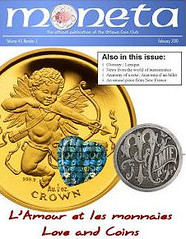 At their May 28 meeting, the members of the Ottawa Numismatic Society voted unanimously in favour of making the Society's award-winning publication, moneta, free for all to enjoy.
At their May 28 meeting, the members of the Ottawa Numismatic Society voted unanimously in favour of making the Society's award-winning publication, moneta, free for all to enjoy.
"The members felt it was important for the promotion of the hobby and numismatic education to make moneta available free to as many people as possible," said Steve Woodland, the Society's president.
moneta was first published in 2010, and that same year won first place in the American Numismatic Association's Outstanding Local Numismatic Publication competition. "Coming in first among 500 competitors - in just our first year of publication - was a great achievement," said editor-in-chief Serge Pelletier, "but given the amazing contributors we have, I was not entirely surprised."
The magazine-format publication is profusely illustrated with large colour images. While it is distributed electronically, it is conceived to be printed. The ten issues of 2010 added up to 282 pages, while the 2011 issues totalled 376 pages. "And we have articles in both English and French," Pelletier said.
"Given that we're the club that serves the Canadian capital, and that we have members from both sides of the Ottawa River [i.e., from Eastern Ontario and western Quebec], the membership felt it was essential to be bilingual," said Woodland.
"During our first two years, the publication's content was, on average, 70% in English and 30% in French," said Pelletier, "but this year, we're happy to say that we're fully bilingual at 50/50."
Money collectors and numismatists are invited to read the publication on the Society's website at www.ons-sno.ca.
NEW BOOK: THE PAPER CURRENCY OF TIBET
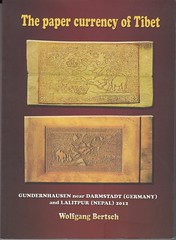 The Paper Currency of Tibet
The Paper Currency of Tibet
By Wolfgang Bertsch
Book Description
Publication date: 2012, First edition
Tibetan banknotes were issued between 1912/13 and 1959. Owing to their artistic design, to their handwritten numbers and intricate seal imprints they can be considered part of Tibet's culture heritage. This book explores the historical background which led to their issue, the way in which they were produced and their artistic design.
Details about book
- Paperback: 274 pages
- Publisher: Thyaka Research Centre, Nakabahil, Nepal (2012)
- Language English
- ISBN-978-99933-982-7-1
- Product Dimensions: 24 x 17.5 x 1.5cm
For more information or to order, see: www.nuphil.com
THE BOOK BAZARRE
A MEMORIAL TRIP TO KEENE, NEW HAMPSHIRE
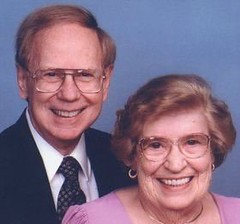 Keene, New Hampshire was the boyhood home of Kenneth Bressett, the indefatigable editor of A Guide Book of United States Coins (the Red Book), who celebrates his 60th year in that position this year. It was in Keene also he met and married Bertha B. Britton 62 years ago in 1950.
Keene, New Hampshire was the boyhood home of Kenneth Bressett, the indefatigable editor of A Guide Book of United States Coins (the Red Book), who celebrates his 60th year in that position this year. It was in Keene also he met and married Bertha B. Britton 62 years ago in 1950.
Ken did some freelance work for Dick Yeo, original editor of both the Blue Book as well as the Red Book. Dick Yeo offered Ken a full time job to come to Racine and assist him with the numismatic publications he planned to publish under the banner of Whitman Publishing. The Bressett couple moved from Keene to Racine in 1959. (Ask Ken sometime who would have been Dick Yeo's second choice had he turned down the position in Racine.)
So Ken's freelance days were over now that he was in a paid position. Now he could give his full attention to Dick Yeo's creations, the venerable Books of Blue or Red bindings no American coin collector could live without. More than 30 million copies have been sold over those 60 years, setting an American publishing record somewhat short of the English language Bible.
The Bressett couple spent two years in Des Moines associated with the Kagins after moving from Racine. Then in 1982 they moved to Colorado Springs to serve the national collectors organization, the ANA, first as director of Certification Service for two years, then as Director of Education for three years.
Bert was at Ken's side all those years, often as hostess at a numismatic function where Ken had some major function. Numismatists knew her and she knew numismatists. On February 12 this year Bert Bressett died after coping with COPD for years. Funeral services were held in Colorado Springs, with a Catholic Mass for the Dead at Saint Paul's Catholic Church in Colorado Springs.. Interment was to be in back in Keene, with a memorial service later in June.
As an adult, my daughter Sandra Johnson Carazza, choose to attend Antioch College in Keene New Hampshire for her doctorate in psychology. She has been living in Keene for four years attending Antioch classes. How fortunate, I thought, I could attend Bert Bressett's Memorial Service, June 8, and also visit my daughter.
The gravesite services were attended by a large number of family and friends. The only numismatic personalities who attended -- in addition to Ken -- was Bill Fivaz and wife Marylyn, my wife Shirley and myself. The Fivazs and the Bressetts had travelled to Hawaii twice. When the priest asked for audience remembrances of Bert Bill recounted their Hawaiian trips, and his fond memories of Bert.
Incidentally, my acquaintance will Bill goes back to days in Danbury, Connecticut in the mid 1960s.when we were both active in the Danbury Coin Club. He was even chairman of some of our all-day coin shows in Danbury Also, Bill was my source of some of the best jokes I ever heard, both numismatic and otherwise. When we would meet at conventions he would always respond with a side-splitter, causing me to reel in laughter.
Bill was far more decorous than I this week. When prompted again for his latest joke, here we were in the grass at the Bressett gravesite. "I can't tell you that in a cemetery" he said.
My recent memories of Bert Bressett was at the FIDEM Exhibition banquet in Colorado Springs in 2007. While the banquet guests were invited out on the veranda to overlook the night lights of Colorado Springs from the mountainside restaurant, I noticed Bert alone at her table. I went over and had a 45-minute conversation with her about Ken, of travels, of family activities and mutual friends. This will remain my fond memory of Bert Bressett.
NOTES FROM E-SYLUM READERS: JUNE 3, 2012
Preserving Historical Names
Skip Lane writes:
I missed the original article regarding the hyphen in New-York but after reading this one I am reminded that several Hard Times Tokens use the hyphen; some with the full spelling, NEW-YORK, some as N-YORK and some as N-Y. I always figured it was just artistic license, I never knew that that was the way it was originally spelled.
Ron Abler writes:
I enjoyed Dick Johnson's contribution about retention of the hyphen in historical names. I agree with Louise Mirrer's defense of the hyphen in the name of the New-York Historical Society. My local coin club is in St. Mary's County, Maryland, but our club name, St. Marie's Coin Club, preserves the county's historical name. It is a small thing, but we take great pride in it.
To read the earlier E-Sylum article, see: THE NEW-YORK HISTORICAL SOCIETY: RESPECT THE HYPHEN! (www.coinbooks.org/esylum_v15n23a13.html)
Michael Annis Contact Information
Dick Doty writes:
A number of our folks will know Michael Annis, a dealer in ancient coins, foreign coins, antiquities, a number of other things, a helpful gent out of Michigan who worked the Whitman show and the ANA conventions. Mike came down with Lou Gehrig's disease, and it's terminal. He's got a few weeks to live at the most, and this past Thursday he moved into the hospice where he'll die. I think it's better to be piped aboard with people wishing you well and thinking good thoughts than not knowing.
I asked Dick to confirm with Mike that it's OK to publish this information, and Mike would be happy to hear from his old numismatic friends. Here is his contact information.
MICHAEL ANNIS
FAIRFAX, BUILDING 1
1900 NORTH PROSPECT ROAD
YPSILANTI,MI 48198
(734) 483-6662
chiefmike45@yahoo.com
Our thoughts go out to Mike and his family in this difficult time. Please do send him your wishes.
PRESIDENTIAL COIN AND ANTIQUE COMPANY AUCTION 82
 31. 102. RARE J. T. JONES, SAN FRANCISCO COUNTERSTAMP. Brunk J-218; Kappen Unlisted as to date on undertype. (1270-1273.) CORNER MONTG & COMMERCIAL ST. around SAN/ J.T. JONES/ FRANCO logotype c/s on a very well worn Bolivian 2 sueldos coin of 1778(?) The c/s is bold.
31. 102. RARE J. T. JONES, SAN FRANCISCO COUNTERSTAMP. Brunk J-218; Kappen Unlisted as to date on undertype. (1270-1273.) CORNER MONTG & COMMERCIAL ST. around SAN/ J.T. JONES/ FRANCO logotype c/s on a very well worn Bolivian 2 sueldos coin of 1778(?) The c/s is bold.
J.(ames) T.(hompson) Jones was the proprietor of the famous Blue Wing Saloon, 138 Montgomery Street. This saloon was one of the most notorious of the Barbary Coast. Its notoriety stemmed in part from the assassination of US Marshall Wm. Richardson by a gambler named Charles Cora after a disagreement which began at the saloon. Cora was later hanged by vigilantes. (I)

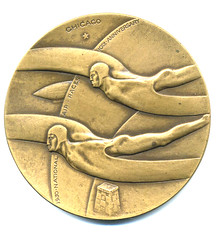
486. 10TH NATIONAL AIR RACES ART DECO MEDAL, 1930. 63.6mm. Bronze. J.W. Hansen, Sc. (MACO). About Uncirculated. The obverse features the helmeted head of an aviator and the legend, THE OLYMPIAD OF THE AIR. The stylized reverse consists of two winged flyers; partial globe and dirigible in the background. The edge of the globe is inscribed; 1930 NATIONAL AIR RACES 19TH ANNIVERSARY. A striking piece of art in a quintessential Art Deco motif! A "must-have" piece for both collectors of this art period and of aeronautics. An AU bronze example brought $552.00 in our 2007 Auction Seventy Seven, #567.

1360. GENERAL MOTORS FIGURAL ASHTRAY, CA 1930's. Copper Plated. Extremely Fine. 3 7/8" diameter, _" high. with a nicely detailed image in center showing the front of car heading towards viewer. An incused inscription below the car reads: GENERAL MOTORS. A tree and mountain accents are on the sides and clouds in background. The lip is inscribed: WHO SERVES PROGRESS SERVES AMERICA. A small bronze plaque on the reverse is inscribed DESIGNED AND PRODUCED/ BY/ TERNSTEDT DIV./ GENERAL MOTORS CORP.
This ashtray is also known chrome plated. One writer has called this an advertising piece for the 1937 Buick. Another has attributed it to the 1933 Chicago World's Fair. We don't know enough to say one way or the other. (F)
WASHINGTON POST ARTICLE ON THIEVES TARGETING COIN DEALERS
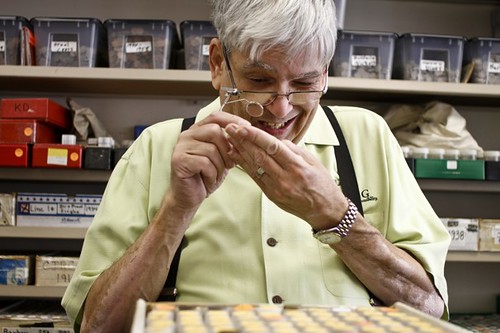
As Julian Leidman packed up more than $4 million in rare coins after a Connecticut show, the thieves probably already had the prominent collector under surveillance and had laid plans for one of the biggest coin heists in U.S. history.
Leidman eased his minivan onto Interstate 95 south toward his Maryland home and the thieves probably followed, waiting and watching for dozens of miles. Then they saw their opening.
When Leidman stopped for dinner at Tiffany's restaurant in Pine Brook, N.J., he took a table near a window so he could keep an eye on his vehicle. The thieves sneaked around the side he couldn't see, smashed a window and took at least five cases.
Thefts of rare coins have spiked in recent years, experts say, crimes linked to the run-up in gold and silver prices. Coin thieves are often part of organized rings, some from Colombia and others with ties to the Russian mafia, that orchestrate sophisticated, lightning-quick and sometimes ruthlessly violent heists, according to the Numismatic Crime Information Center, a nonprofit organization that tracks coin thefts.
Fairfax County police think thieves probably followed a dealer to his Annandale home after a show in April and snatched coins and banknotes worth as much as $500,000 when the dealer left his car for about 10 minutes. In 2011, a mother and son from Texas were convicted of being part of a scheme to steal $152,000 in coins from a New Market, Va., collector.
"Why rob a bank with cameras, witnesses, and there's a good chance your picture will end up on the evening news?" said Steve Ellsworth, president of the Virginia Numismatic Society and a coin security expert. "Coin thefts often don't have witnesses, and criminals can make off with far more money."
The October 2009 scheme targeting Leidman, which has resulted in a case that is nearing its conclusion in federal court in New York, opens a window on the world of thefts that sometimes seems pulled from a Hollywood script.
To read the complete article, see:
Driven by gold and silver prices, thieves target coin collections
(www.washingtonpost.com/local/crime/driven-by-gold-and-silver
-prices-thieves-target-coin-collections/2012/06/10/gJQAouh5SV_story.html)
QUERY: EARLY EDITION OF RAYMOND'S STANDARD CATALOGUE OF U.S. COINS
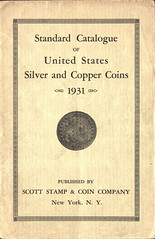 Conventional wisdom has it that the first edition of the Standard Catalogue of United States Coins was the 1934 hardcover book published by Wayte Raymond, Inc. In the course of searching for old coin album ads I acquired an earlier edition published with paper covers by the Scott Stamp & Coin Company. It was compiled by Raymond but not published by him. This book has a cover date of 1931 but is copyrighted 1930 and described on the title page as the second edition. Evidently there was another one a year or two earlier.
Conventional wisdom has it that the first edition of the Standard Catalogue of United States Coins was the 1934 hardcover book published by Wayte Raymond, Inc. In the course of searching for old coin album ads I acquired an earlier edition published with paper covers by the Scott Stamp & Coin Company. It was compiled by Raymond but not published by him. This book has a cover date of 1931 but is copyrighted 1930 and described on the title page as the second edition. Evidently there was another one a year or two earlier.
I don't believe I've seen this earlier version mentioned in print before, though I imagine some bibliophiles already have a copy. While the book is slim and lists the higher denominations by type alone, it is otherwise identical in format to the later Raymond catalogs. The photos are the same ones used in 1934 and for the next several years.
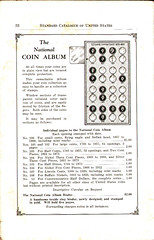 The payoff for me was a nice ad for the National Coin Album, even though it turned out to be the same one then running in The Numismatist. 1930 was the year that Wayte Raymond acquired the rights to M. L. Beistle's coin albums, though the latter's company continued to manufacture them for Raymond and his successor, Alan Faxon, as late as 1967. Raymond initially marketed these albums solely through Scott Stamp & Coin Company, but this relationship ended a few years later.
The payoff for me was a nice ad for the National Coin Album, even though it turned out to be the same one then running in The Numismatist. 1930 was the year that Wayte Raymond acquired the rights to M. L. Beistle's coin albums, though the latter's company continued to manufacture them for Raymond and his successor, Alan Faxon, as late as 1967. Raymond initially marketed these albums solely through Scott Stamp & Coin Company, but this relationship ended a few years later.

THE SMELL OF MONEY
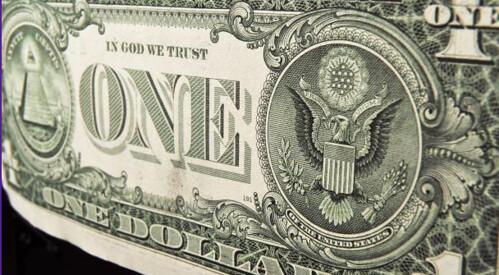
Sarah Gardner: So you've heard of drug-sniffing dogs, right? Well today we read about a new role for canines in place like Argentina -- dollar sniffers. Yes, they have been trained to sniff out dollars to combat the black market in greenbacks.
So it got us thinking: What does money smell like? Dollars are made of cotton and linen, and according to the Treasury's Bureau of Printing and Engraving, different types of inks are used on different denominations. But really the smell is affected by what the dollar comes in contact with -- dirt, sweat and yes, cocaine, according to research by the Argonne National Laboratories in Chicago.
To understand all of this a little bit more we reached out to Stuart Firestein at Columbia University's Department of Biological Sciences. Welcome to the program.
Stuart Firestein: Thank you. Nice to be here.
Gardner: Listen I have to ask you: What do you call someone like yourself? What's the official title for someone who is an expert on smells?
Firestein: We call the field the sense of olfaction, is the true word for the sense of smell. So there's olfaction for smell and gustation for taste. But in the end everybody just calls me a smell expert, I'm afraid.
Gardner: OK. There's nothing like "smell-ologist?"
Firestein: No, no. We don't have that one yet.
Gardner: OK. So what about money? Does it have a unique smell?
Firestein: Well apparently so since dogs are able to smell it. I've always thought it did myself personally. You can always catch that, especially new bills.
Gardner: That's right. We talk about the scent of fresh money and you think of people of smelling fresh dollar bills. Well after your hands get on it, isn't not so fresh, right?
Firestein: Picks up all sorts of ugly stuff. So it wouldn't be a bad idea to deodorize it every now and again, I suppose.
Gardner: Now I read that money is basically cotton and linen. Do those have distinctive scents?
Firestein: They're very light. So again I think it's primarily the ink rather than the paper in this particular case that gives off the odor.
To read the complete article, see: Sniffing out what money smells like (www.marketplace.org/topics/life/sniffing-out-what-money-smells)
WAYNE'S NUMISMATIC DIARY: JUNE 17, 2012
Tuesday night I walked into the Max Fox Brewing Company in Falls Church, VA. It was time for the monthly gathering of my northern Viginia numismatic social group Nummis Nova. Gene Brandenberg, Ron Abler, Dave Schenkman, Howard Daniel and Mike Packard were already there, occupying one end of a long table. The place was already pretty full of happy hour patrons with nearly every table occupied. Howard had just that afternoon returned from his trip to Memphis for the paper money show.
Julian Liedman couldn't make it, but everyone was talking about Tuesday's article in the Washington Post about the trend in coin dealer robberies. The article prominently featured Julian with a photo of him at work in his shop (see a separate E-Sylum item in this issue for an excerpt). We didn't have a particular theme this evening. I brought along some items I'd found in a desk drawer at home. It's amazing what can happen when you put the keyboard down and actually deal with the physical world - I came across stuff I'd forgotten I had, including a group of lottery tickets, two nice pieces of 1907 Clearing House certificates, and letter from John Kraljevich dated 1992 (wasn't he in diapers back then? I imagine the stock-trading baby from the TV commercials, making wisecracks about colonial history and contemporary coin dealers).
The lottery tickets were mostly from the 1875-1950 era, but one was an early Washington Canal ticket. A number of folks remarked on its historical significance. I has a number of early Washington D.C. lottery tickets, and joked that if one of them was a winner then I might actually own the South Portico of the Capitol. The Clearing House Certificates came to me in a letter from Tom Sheehan. I'd like to think I long ago sent him the $75 payment he requested.... He hasn't been calling me a deadbeat, so I figure we're OK.
Eric Schena brought along a copy of a book he'd written on the decorations of communist Albania. More next week, including some images of the items I brought along. I'm on the road this weekend and will have to stop here.
THE NUMISMATOURIST'S LATEST TRAVELS IN EUROPE
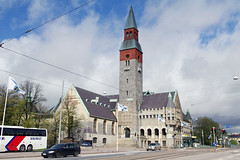 The Numismatourist (aka Howard Berlin) has recently returned from visiting Helsinki, Hamburg, and for the second time this year, Berlin. It had been 44 years (1968) since I had last visited Helsinki so I had no idea what it was like then. I paid a visit to the National Museum of Finland which has an exhibition of coins, medals, banknotes, orders and decorations in more than 22 cases in the lower level/basement in an area called the "Treasure Troves," under the control of its head keeper, Dr. Tuukka Talvio. All text, except for a few panels, are in Finnish, Swedish, and English.
The Numismatourist (aka Howard Berlin) has recently returned from visiting Helsinki, Hamburg, and for the second time this year, Berlin. It had been 44 years (1968) since I had last visited Helsinki so I had no idea what it was like then. I paid a visit to the National Museum of Finland which has an exhibition of coins, medals, banknotes, orders and decorations in more than 22 cases in the lower level/basement in an area called the "Treasure Troves," under the control of its head keeper, Dr. Tuukka Talvio. All text, except for a few panels, are in Finnish, Swedish, and English.
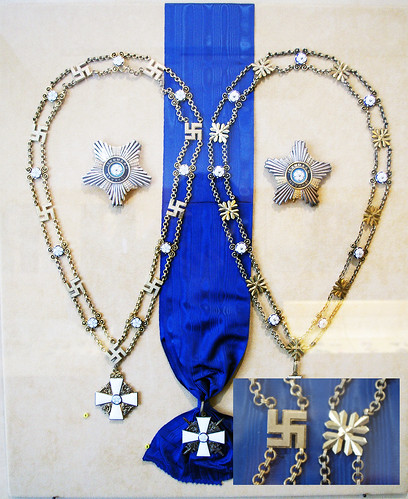
Order of the White Rose of Finland Grand Cross
Among the exhibits, I found two unusual items. One was the Order of the White Rose of Finland Grand Cross with Collar, one of three official orders of Finland. The original collar's design, from 1919 had nine swastikas alternating with nine white roses. Even though the swastika had long been a symbol associated with ancient civilizations of the Indus valley rather than the Nazis, it was replaced in 1963 by fir crosses. Believe it or not, not all plate money is from Sweden. The other item on display is a very rare Russian 1726 10-kopeck plate money.
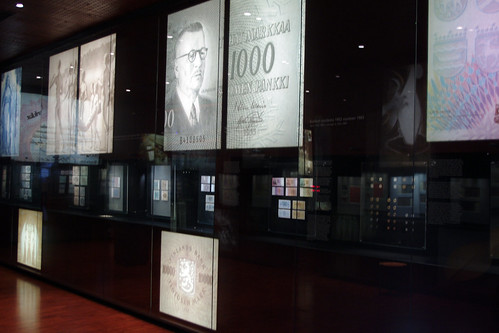
Gallery exhibits of the National Bank of Finland Museum
The central bank's museum, The National Bank of Finland, is headed by Mr. Jaakko Koskentola, who I had the pleasure of meeting and acted as my tour guide. The exhibits are divided into three areas: the permanent numismatic exhibit consisting primarily of banknotes, the informational exhibit about its role as Finland's central bank, and a temporary exhibition. The latter was about Finland's last Markkaa which, displayed in public for the first time, actual artists' banknote designs for all denominations of the last Markkaa series. Like the National Museum, all informational text is in three languages: Finnish, Swedish, and English. The museum is in separate building from the Bank of Finland, only one block down the street.
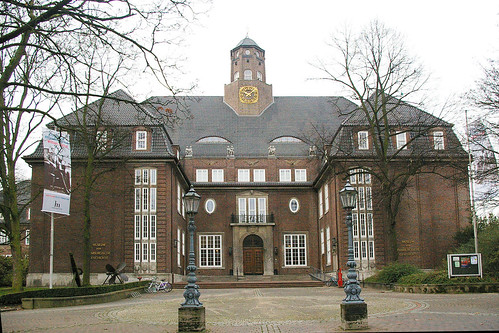
Hamburg History Museum
While in Hamburg, I wisely chose to revisit visit the coin exhibit of the Hamburg History Museum (from 4 years ago) instead of the infamous Reeperbahn district. Text is in German and English. The major exhibit are coins from the 15th and 16th century from around Hamburg.
In a not so shameless promotion, these three sites, as many of the others I have discussed in past issues of The E-Sylum, plus more than 100 others are included in my book, "The Numismatourist: The Only World-Wide Travel Guide to Museums, Mints, and Other Places of Interest for the Numismatist." This is to be published either later this year or early next year by Zyrus Press.
DONOR REPATRIATING 10,000 HISPANIC COINS TO ANS
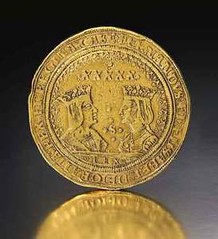 One's worst fears are now being realized regarding the Hispanic Society of America's recent sale of 37,895 coins. This incomparable collection---the entire history of Spain, from the 5th century B.C. to the early 20th century, stamped in gold, silver and bronze---had been given to the HSA (a New York City institution devoted to Spanish art, literature and history) by founder Archer Milton Huntington. Now it is being broken up and is likely to be widely dispersed.
One's worst fears are now being realized regarding the Hispanic Society of America's recent sale of 37,895 coins. This incomparable collection---the entire history of Spain, from the 5th century B.C. to the early 20th century, stamped in gold, silver and bronze---had been given to the HSA (a New York City institution devoted to Spanish art, literature and history) by founder Archer Milton Huntington. Now it is being broken up and is likely to be widely dispersed.
Although the HSA's director, Mitchell Codding, had told the NY Times last fall that the coins would be sold only to another public institution, they were (after attempts to find an institutional buyer failed) offered to all comers in a sealed-bid auction at Sotheby's that ended on Mar. 8. Although they were sold as one lot, there were no strings attached regarding the possible (now likely) dispersal of the collection through resales.
The winning bidder---thought to be a dealer consortium that included Jesús Vico, a prominent coin seller in Madrid---is now breaking up this previously important cultural and scholarly resource. Some 1,004 coins are being offered at a Vico auction on June 26.
The good news is that some 10,000 of the dispersed coins are returning to the American Numismatic Society, the institution that had custody of them since 1949 and never expected to lose them. Among those retrieved were the pieces that the ANS most coveted---some 1,004 coins of the Visigoths, for which the HSA's holdings were second to none. Those coins are already in ANS's hands, with the rest expected to arrive tomorrow. (More details on those coins, below.)
Placed on loan at the ANS by the HSA, at the direction of Huntington, the entire trove was hauled away last year for sale through Sotheby's, after the ANS unsuccessfully attempted in State Supreme Court to prevent the disposal. Huntington had explicitly given the HSA permission to recall the loaned coins at any time, but surely never envisioned their removal for disposal.
But let's get back to the silver lining of this murky story, as described to me by Ute Wartenberg Kagan, the ANS's executive director (who revealed that she had "heard from a number of people" that the winning bid at Sotheby's was "slightly over $26 million").
Kagan said that the return of 10,000 coins to her New York City institution will greatly enhance the public accessibility of the ex-HSA treasure, which had been tucked away in storage and seen mostly by scholars. When the coins were previously at the ANS, they had been restricted by the HSA's rules and could not (with rare exceptions) be publicly exhibited. Under new ownership, they can now be displayed however and whenever the ANS pleases. A future public display (perhaps to be mounted off site, instead of being confined to the ANS's relatively small exhibition area) is being contemplated.
While the ANS hopes eventually to receive a donation of these coins, they are currently on permanent loan from their purchaser, an ANS benefactor who wants to remain anonymous. Having just received the catalogue for the Vico auction, Kagan said she was looking it over with an eye to additional ANS acquisitions.
To read the complete article, see: News Flash: 1,004 Ex-Hispanic Society Coins to Be Re-Auctioned in Spain; American Numismatic Society Retrieves 10,000 Pieces (www.artsjournal.com/culturegrrl/2012/06/american_numismatic_society_re.html)
THE BOOK BAZARRE
BAR-KOCHBA ERA TREASURE HOARD DISCOVERED
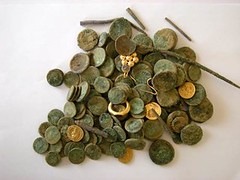 Archaeologists have discovered a treasure trove comprising about 140 gold and silver coins along with gold jewelry, probably hidden by a wealthy lady at a time of impending danger during the Bar Kokhba Revolt some 1880 years ago.
Archaeologists have discovered a treasure trove comprising about 140 gold and silver coins along with gold jewelry, probably hidden by a wealthy lady at a time of impending danger during the Bar Kokhba Revolt some 1880 years ago.
The Israel Antiquities Authority (IAA) presented the sumptuous find Tuesday and said it was recently exposed in a salvage excavation in the vicinity of Kiryat Gat, in southern Israel.
The rooms of a building dating to the Roman and Byzantine period were exposed during the course of the excavation. Archeologists discerned that a pit had been dug in the earth of the ancient building's courtyard and then refilled. To the archaeologists' delightful surprise, a spectacular treasure trove of exquisite quality was discovered in the pit. It had been wrapped in a cloth fabric that had mostly deteriorated.
According to archaeologist Emil Aladjem, who directed the excavation on behalf of the IAA, "The magnificent hoard includes gold jewelry, among them an earring crafted by a jeweler in the shape of a flower and a ring with a precious stone on which there is a seal of a winged-goddess, two sticks of silver that were probably kohl sticks, as well as some 140 gold and silver coins."
"The coins that were discovered date to the reigns of the Roman emperors Nero, Nerva and Trajan, who ruled the Roman Empire from 54-117 CE. The coins are adorned with the images of the emperors and on their reverse are cultic portrayals of the emperor, symbols of the brotherhood of warriors and mythological gods such as Jupiter seated on a throne or Jupiter grasping a lightning bolt in his hand."
Sa'ar Ganor, District Archaeologist of Ashkelon and the Western Negev for the IAA, added that "the composition of the numismatic artifacts and their quality are consistent with treasure troves that were previously attributed to the time of the Bar Kokhba Revolt. During the uprising, between 132-135 CE, the Jews under Roman rule would re-strike coins of the emperor Trajan with symbols of the revolt."
"This hoard includes silver and gold coins of different denominations, most of which date to the reign of the emperor Trajan. This is probably an emergency cache that was concealed at the time of impending danger by a wealthy woman who wrapped her jewelry and money in a cloth and hid them deep in the ground prior to or during the Bar Kokhba Revolt. It is now clear that the owner of the hoard never returned to claim it."
To read the complete article, see: Bar-Kochba Era Treasure Hoard Discovered (www.israelnationalnews.com/News/News.aspx/156552)
RUMORS DRIVE CROWDS TO PURCHASE ONE-RUPEE COINS
The one-rupee coin might be much more valuable than it seems, or at least that is what many in Swat have been led to believe. Rumours that the coins contain gold caused a stir in Swat Valley, with people clamouring to get their hands on it, some paying as much as Rs50 to Rs100 for a single coin.
"I bought some coins for Rs60 to Rs70 each, spending Rs5,000, and will sell them to a dealer on profit," said Izhar, a resident of Amankot.
In Mingora Bazaar, people seemed to be in a rush. While some were buying the coins, others seemed more intent on selling and bargaining.
"In the morning, one coin was sold for Rs35 but later on the price reached Rs100. Some dealers have invested hundreds of thousands of rupees in the coins. But no one knows how and where to find an upper market," said Samiullah, a shopkeeper.
This new surge has overwhelmed people of all ages. At their homes, women are busy collecting the coins, whereas children and men are on a blind hunt for the bronze-coloured coin.
"Since morning, hundreds of people have come to enquire about the one-rupee coins. They demand it even for Rs100. I don't know if it's worth it but I've set aside some 80 coins to sell on profit," said Fazal Wahid a shopkeeper in Sethi Mills Mohallah.
This is not the first time that the rumour has swept the valley. Elders recall similar rumours in the past.
"I went bankrupt due to such baseless rumours back in 1970. Two men circulated 10-paisa coins in the market, claiming that they had gold in them. I spent thousands of rupees on the coins. But none of the dealers would buy them," lamented Umar Ali, an elderly man.
Banks said that there is no gold in the coins and that people should refrain from such dealings.
To read the complete article, see: Wild Goose Chase: The Worth of One Rupee (tribune.com.pk/story/390859/wild-goose-chase-the-real-worth-of-one-rupee/)
To read the earlier E-Sylum article, see: THE GOLDEN CENTS (www.coinbooks.org/esylum_v03n31a08.html)
EDWARD VIII'S HIDDEN WATCH COIN
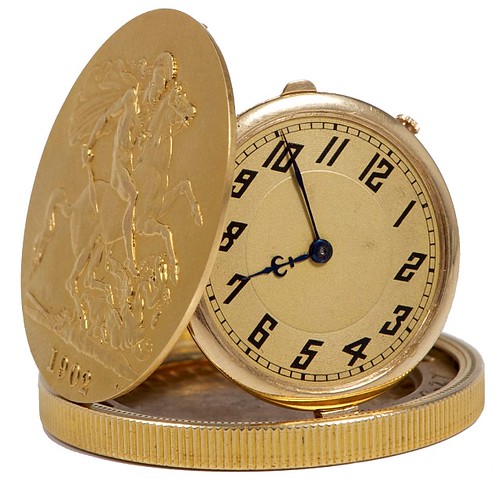
An intricate watch concealed within a gleaming £5 gold coin that was a love gift from King Edward VIII to his first mistress is expected to sell for thousands when it goes under the hammer next week.
The young Prince of Wales gave the beautiful token of his affection to Freda Dudley Ward some years after he had a passionate affair with the married socialite in 1918.
The pair had romantically met in a doorway in London's Mayfair as they sheltered from a Zeppelin raid during the First World War.
The Prince of Wales broke off the relationship in 1934 when Wallis Simpson came into his life - the relationship which sparked the dramatic abdication crisis.
Prince Edward was presented with the wafer-thin watch, created inside the 1902 £5 gold coin, when he opened the Scottish Motor Exhibition in 1927 and had it engraved with the initials 'F' and 'D', for his pet name David, and presented it to his secret lover.
To read the complete article, see:
Stunning watch hidden inside £5 coin King Edward gave to the mistress he dumped for Wallis Simpson expected
to fetch £15,000 at auction
(www.dailymail.co.uk/news/article-2157661/Stunning-watch-hidden-inside
-5-coin-King-Edward-gave-mistress-expected-fetch-15-000-auction.html)
FEATURED WEB PAGE: THE ROYAL MINT MUSEUM
This week's Featured Web Page is The Royal Mint Museum.The Royal Mint Museum has one of the finest collections of coins and related material in the world.
It is a collection about how money is made and how the Royal Mint has evolved over the last 1100 years.

www.royalmintmuseum.org.uk
